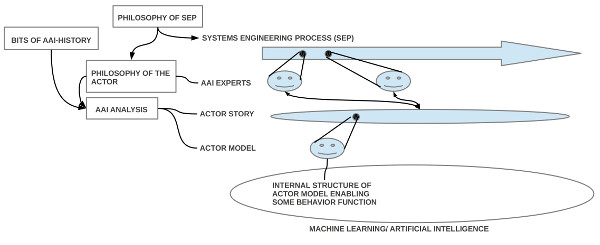eJournal: uffmm.org
ISSN 2567-6458, 4.May – 16.March 2021
Email: info@uffmm.org
Author: Gerd Doeben-Henisch
Email: gerd@doeben-henisch.de
CONTEXT
In this section several case studies will be presented. It will be shown, how the DAAI paradigm can be applied to many different contexts . Since the original version of the DAAI-Theory in Jan 18, 2020 the concept has been further developed centering around the concept of a Collective Man-Machine Intelligence [CM:MI] to address now any kinds of experts for any kind of simulation-based development, testing and gaming. Additionally the concept now can be associated with any kind of embedded algorithmic intelligence [EAI] (different to the mainstream concept ‘artificial intelligence’). The new concept can be used with every normal language; no need for any special programming language! Go back to the overall framework.
COLLECTION OF PAPERS
There exists only a loosely order between the different papers due to the character of this elaboration process: generally this is an experimental philosophical process. HMI Analysis applied for the CM:MI paradigm.
JANUARY 2021 – OCTOBER 2021
- HMI Analysis for the CM:MI paradigm. Part 1 (Febr. 25, 2021)(Last change: March 16, 2021)
- HMI Analysis for the CM:MI paradigm. Part 2. Problem and Vision (Febr. 27, 2021)
- HMI Analysis for the CM:MI paradigm. Part 3. Actor Story and Theories (March 2, 2021)
- HMI Analysis for the CM:MI paradigm. Part 4. Tool Based Development with Testing and Gaming (March 3-4, 2021, 16:15h)
APRIL 2020 – JANUARY 2021
- From Men to Philosophy, to Empirical Sciences, to Real Systems. A Conceptual Network. (Last Change Nov 8, 2020)
- FROM DAAI to GCA. Turning Engineering into Generative Cultural Anthropology. This paper gives an outline how one can map the DAAI paradigm directly into the GCA paradigm (April-19,2020): case1-daai-gca-v1
- CASE STUDY 1. FROM DAAI to ACA. Transforming HMI into ACA (Applied Cultural Anthropology) (July 28, 2020)
- A first GCA open research project [GCA-OR No.1]. This paper outlines a first open research project using the GCA. This will be the framework for the first implementations (May-5, 2020): GCAOR-v0-1
- Engineering and Society. A Case Study for the DAAI Paradigm – Introduction. This paper illustrates important aspects of a cultural process looking to the acting actors where certain groups of people (experts of different kinds) can realize the generation, the exploration, and the testing of dynamical models as part of a surrounding society. Engineering is clearly not separated from society (April-9, 2020): case1-population-start-part0-v1
- Bootstrapping some Citizens. This paper clarifies the set of general assumptions which can and which should be presupposed for every kind of a real world dynamical model (April-4, 2020): case1-population-start-v1-1
- Hybrid Simulation Game Environment [HSGE]. This paper outlines the simulation environment by combing a usual web-conference tool with an interactive web-page by our own (23.May 2020): HSGE-v2 (May-5, 2020): HSGE-v0-1
- The Observer-World Framework. This paper describes the foundations of any kind of observer-based modeling or theory construction.(July 16, 2020)
- CASE STUDY – SIMULATION GAMES – PHASE 1 – Iterative Development of a Dynamic World Model (June 19.-30., 2020)
- KOMEGA REQUIREMENTS No.1. Basic Application Scenario (last change: August 11, 2020)
- KOMEGA REQUIREMENTS No.2. Actor Story Overview (last change: August 12, 2020)
- KOMEGA REQUIREMENTS No.3, Version 1. Basic Application Scenario – Editing S (last change: August 12, 2020)
- The Simulator as a Learning Artificial Actor [LAA]. Version 1 (last change: August 23, 2020)
- KOMEGA REQUIREMENTS No.4, Version 1 (last change: August 26, 2020)
- KOMEGA REQUIREMENTS No.4, Version 2. Basic Application Scenario (last change: August 28, 2020)
- Extended Concept for Meaning Based Inferences. Version 1 (last change: 30.April 2020)
- Extended Concept for Meaning Based Inferences – Part 2. Version 1 (last change: 1.September 2020)
- Extended Concept for Meaning Based Inferences – Part 2. Version 2 (last change: 2.September 2020)
- Actor Epistemology and Semiotics. Version 1 (last change: 3.September 2020)
- KOMEGA REQUIREMENTS No.4, Version 3. Basic Application Scenario (last change: 4.September 2020)
- KOMEGA REQUIREMENTS No.4, Version 4. Basic Application Scenario (last change: 10.September 2020)
- KOMEGA REQUIREMENTS No.4, Version 5. Basic Application Scenario (last change: 13.September 2020)
- KOMEGA REQUIREMENTS: From the minimal to the basic Version. An Overview (last change: Oct 18, 2020)
- KOMEGA REQUIREMENTS: Basic Version with optional on-demand Computations (last change: Nov 15,2020)
- KOMEGA REQUIREMENTS:Interactive Simulations (last change: Nov 12,2020)
- KOMEGA REQUIREMENTS: Multi-Group Management (last change: December 13, 2020)
- KOMEGA-REQUIREMENTS: Start with a Political Program. (last change: November 28, 2020)
- OKSIMO SW: Minimal Basic Requirements (last change: January 8, 2021)

